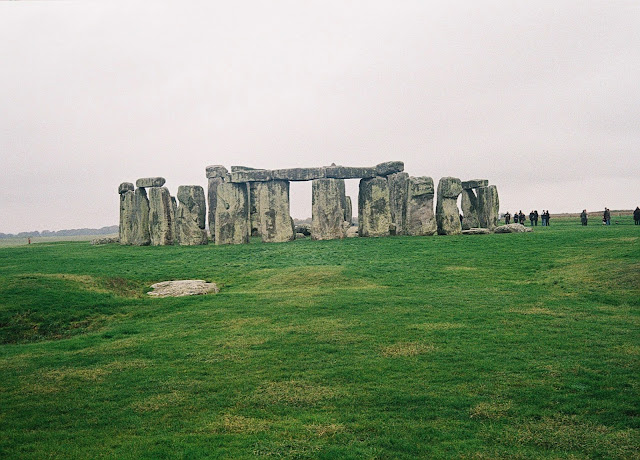rocks of ages
In this digital age, the concept of a printed calendar is somewhat old fashioned. As I am clearly one of those still vehemently holding on to the past, I was considering creating a 2014 calendar from some of my favourite photos throughout 2013. The photo selected for each month would have to have been taken on the same month of the year. Sort of a fun photography project. In the process of selecting the photos, I came across some photos I took at my last visit to Stonehenge. Apt is it not?
I read somewhere that the earliest recorded date in history is 4236 B.C (young Earth creationists rejoice), by the very ancient Egyptians who first devised the 365 days a year calendar. The same one we use today with the minor 6 hour per year adjustment. Seems obvious to us now – it’s based on the movement of celestial bodies. However, kudos to the Egyptians of old for choosing the correct celestial bodies to track, namely the sun, moon, and the ‘dog star’ Sirius, which they noticed rose next to the sun every 365 days. They were also fortunate to have the great river Nile which inundated roughly at the same time of the year – which they no doubt already had festivals of some kind to mark.
Present day Iraq (and parts of Turkey and that general area) hosted two lots of astonishing civilizations - first the Sumerians and then the Babylonians. The Sumerians had 30 day months and 12 hour days while Babylonians alternated the days of the month between 29 and 30 (they were a bit off at 354 days a year, but they were aware of the leap year issue clearly).
No talk of historic calendars can leave out the magnificent Maya and Aztec (as we were reminded by the then impending end of the word very recently in December 2012 – Last northern hemisphere winter Solstice). The Maya also independently arrived at 365 days, using a third celestial body just like the Egyptians did, but they used Venus rather than Sirius the dog.
Talking of Venus and dogs, the Yoruba in west Africa have an ancient saying: “Aguala n ba Osu rin, won sebi aja re ni i se. Aguala ki i se aja Osupa” – Venus travels with the moon, they assume it to be her dog. Venus is not the moon’s dog.
Stonehenge is old. Very old. It is estimated to be over 4000 years old, but nobody knows exactly how old the structure is. There are no written records by the builders; as such it is ‘pre-historic’. It is a favourite of alien conspiracy theorists, olde-religion hipsters, and crazies the world over. However, it is known that one of its functions was as a calendar of some kind. It aligns with various celestial bodies, especially the sun, at notable times of the year at which time it hosts all manner of interest groups.
I’ve seen Stonehenge a number of times, but I’m always humbled in its presence. If you need some perspective on how microscopically minuscule your time on earth really is in the grand scale of things, then visit Stonehenge.
I read somewhere that the earliest recorded date in history is 4236 B.C (young Earth creationists rejoice), by the very ancient Egyptians who first devised the 365 days a year calendar. The same one we use today with the minor 6 hour per year adjustment. Seems obvious to us now – it’s based on the movement of celestial bodies. However, kudos to the Egyptians of old for choosing the correct celestial bodies to track, namely the sun, moon, and the ‘dog star’ Sirius, which they noticed rose next to the sun every 365 days. They were also fortunate to have the great river Nile which inundated roughly at the same time of the year – which they no doubt already had festivals of some kind to mark.
Present day Iraq (and parts of Turkey and that general area) hosted two lots of astonishing civilizations - first the Sumerians and then the Babylonians. The Sumerians had 30 day months and 12 hour days while Babylonians alternated the days of the month between 29 and 30 (they were a bit off at 354 days a year, but they were aware of the leap year issue clearly).
No talk of historic calendars can leave out the magnificent Maya and Aztec (as we were reminded by the then impending end of the word very recently in December 2012 – Last northern hemisphere winter Solstice). The Maya also independently arrived at 365 days, using a third celestial body just like the Egyptians did, but they used Venus rather than Sirius the dog.
Talking of Venus and dogs, the Yoruba in west Africa have an ancient saying: “Aguala n ba Osu rin, won sebi aja re ni i se. Aguala ki i se aja Osupa” – Venus travels with the moon, they assume it to be her dog. Venus is not the moon’s dog.
Stonehenge is old. Very old. It is estimated to be over 4000 years old, but nobody knows exactly how old the structure is. There are no written records by the builders; as such it is ‘pre-historic’. It is a favourite of alien conspiracy theorists, olde-religion hipsters, and crazies the world over. However, it is known that one of its functions was as a calendar of some kind. It aligns with various celestial bodies, especially the sun, at notable times of the year at which time it hosts all manner of interest groups.
I’ve seen Stonehenge a number of times, but I’m always humbled in its presence. If you need some perspective on how microscopically minuscule your time on earth really is in the grand scale of things, then visit Stonehenge.






Comments
Post a Comment